
LIFE BELOW WATER
Healthy oceans and seas are essential to our existence. They cover 70 percent of our planet, and we rely on them for food, energy, and water. Yet, we have managed to do tremendous damage to these precious resources. We must protect them by eliminating pollution and overfishing and immediately start to responsibly manage and protect all marine life around the world.
Water provides the key to natural resources, including food, medicines, biofuels, and other products. Over three billion people bank on coastal biodiversity for their living. Oceans cover three-quarters of the earth's surface. Increasing amounts of waste in the ocean have a major impact on the environment. The damage cannot be reversed, but effort must be made to prevent further exploitation. Nitte (Deemed to be University) is commuted to be the part of awareness programs to minimize the severity of the problem.
Nitte DU follows and promote Use, Reuse, and Recycle in and off- campus. Water retaining material like cloth / gunny bags etc, during curing, ponding for retaining water on flat concrete structures for curing, curing chemicals / techniques to minimize water requirements, non- potable water (STP) for construction activities, water-efficient plumbing fixtures like push-cock taps, sensor-based taps, aerators, pressure inhibitors, and flow regulators for ensuring constant flow, Separate pipelines for potable water, water for recycling and treated water are provisioned for during construction, provision for rainwater harvesting, provision for management of stormwater, rainwater storage ponds have been created in the campus for storage of storm water, rainwater from an artificially created storage pond from an external location near the campus is used. A MoU has been signed with the land-owner for the use of this water, use of recycled water for flushing and gardening, reminder boards to save water.
Additionally, Nitte University is actively work on the sustainable development goals 14 through various academic activities, research activities, various outreach programs, various awareness programs and national and international collaborations.
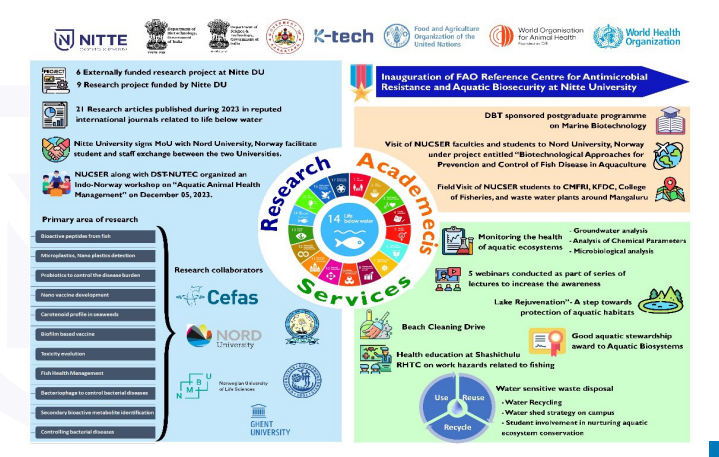
PROACTIVE STEPS TAKEN BY NU
Research: National and International funded research projects
- Department of Biotechnology, Government of India sponsored postgraduate programme on Marine Biotechnology at Nitte University Centre for Science Education & Research (NUCSER)./li>
- Centre of Excellence in Aquamarine Innovation in Dakshina Kannada is established through Karnataka Innovation and Technology Society (KITS), Dept. of ITBT, GoK
- Contract for services for whole genome sequencing of Streptococcus agalactiae serotypes in Indian aquatic systems funded by CEFAS24-29 (Centre for Environment Fisheries and Aquaculture Science, UK)
- Biotechnological approaches for prevention and control of fish disease in aquaculture (BIOAQUA) funded by India-Norway Collaborative Project, Department of Science & Technology (DST), Government of India.
- Deciphering the pathogenicity of Zoonotic pathogen Streptococcus agalactiae obtained from fish funded by Vision Group on Science and Technology (VGST) Grant, India.
- DST-Technology Enabling centre (TEC) funded by Department of Science and Technology, Government of India.
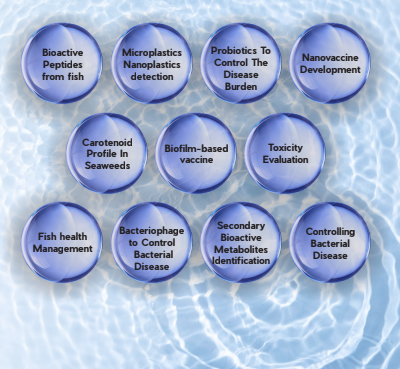
Research project funded by Nitte (Deemed to be University):
- Exploring the association of microorganisms with microplastics in aquatic environment
- Investigating the bioactivity of marine macroalgae extract
- Characterization of bacteriocin produced by probiotic bacteria for application against bacterial fish pathogens
- Perilous marine hitchhikers: Assessing the potential of marine plastics
in the transport of human pathogenic bacteria in the coastal
environment of Karnataka
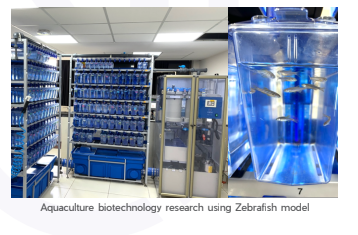
- Evaluation of fin regeneration potential of Parkia javanica fruit and bark extracts in zebrafish
- Generation of Ro60 knockout zebrafish mutant using CRISPR cas9 gene editing tool
- Cloning and sequencing of outer membrane protein encoding gene of Edwardsiella
- Effects of phthalates in reproductive health of Zebrafish
- Evaluation of biofilm formation of fish pathogen for oral vaccination of fish
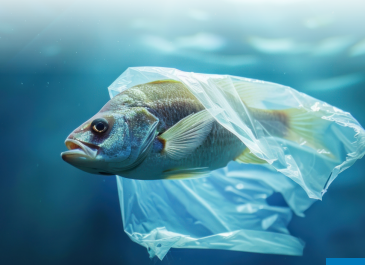
Currently, plastic pollution is considered a global threat because of its widespread presence within the aquatic and terrestrial food webs. Plastic debris has been a major source of anthropogenic contamination in the aquatic environment. Plastic surfaces colonized by pathogenic bacteria could serve as a potential vector for the dissemination of antibiotic resistant pathogens to distant places. The potential transport of human pathogens through plastic debris and its risk to the seafood species is alarming as it is concerned with food safety and security. The increasing scientific consensus on the indirect effect of plastics and lacuna of studies in the warm tropical southwest coastal belt of India prompted us to take up this investigation.
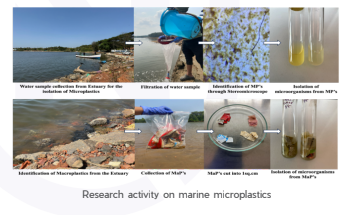
Development of rapid detection of Enterocytozoon Hepatopenaei in shrimp:
Isothermal amplification techniques, such as Recombinase Polymerase Amplification (RPA), is developed to detect Enterocytozoon Hepatopenaei in shrimp. RPA can be conducted within a short time frame of 15?30 minutes at a moderate temperature range of 25?37?C. It is an extremely sensitive and selective isothermal amplification technique with minimal sample preparation and capable of amplifying as few as 10 target DNA copies in a very short time. These isothermally amplified products can be detected using Clustered Regularly Interspaced Short Palindromic Repeats (CRISPR) technology with a specific Cas protein that can be linked to fluorescent signals. Combining RPA with the CRISPR-Cas12a assay offers an effective pathogen diagnostic method for point-of-care testing.

International collaborations :
Nitte DU is involved through an ongoing research project with the scientist of Norway, through collaborative research project ?Biotechnological approaches to prevent and control fish disease in aquaculture (BIOAQUA).? This project has been financially supported by the Department of Science & Technology (DST), Government of India, with a budget of Rs. 45 lakhs. The aim was to promote scientific renewal and development of disciplines and/or to generate new knowledge about issues relevant to both societies in mutually agreed fields and to achieve bilateral world-class scientific results in the field of bioeconomy.
ACTIVITIES AND COMMUNITY OUTREACH PROGRAMME
Health education at Shashithulu RHTC on work hazards related to fishing:
Dr Stephie, Dr Sujay and Dr Pradnya conducted a health education session for the fishermen in Sasihithlu Beach on 20th February 2023. Occupational hazards related to fishing and different ways to prevent them were discussed. They were educated on the hazards of prolonged exposure to the sun which could lead to dehydration and sometimes, skin cancer. Advised to watch out for symptoms like redness, scaly lesions, and blisters. Practices like bathing twice a day, wearing fresh, clean clothes, hand washing and living in a clean environment were impressed upon them. They were also taught the importance of staying hydrated and informed of the different beverages that had good electrolyte and nutritional value.
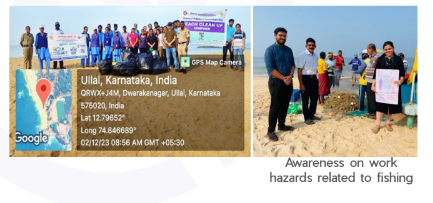
Beach Cleaning Drive:
- A beach cleaning drive was organised by NSS Unit on 30th September 2023 at Malpe Beach, Udupi District to commemorate Mahatma Gandhi Jayanti and Lal Bahadur Shastri Jayanthi and as a part of Swachh Bharat Abhiyan. Nearly 50 student volunteers have participated in cleaning and collected around 20 bags of waste.
- As a part of community engagement activity, students cleaned the surroundings of Ul lal Beach, Mangalore on 14th October 2023.
- The NSS unit of NIPE, in partnership with United Way, Mumbai, organized impactful Beach Cleaning Drives on 17th Oct and 21st Nov 2023 at Bengre Beach. More than 69 volunteers participated in the activity. The purpose was not only to ensure a beautiful coastline but also help maintain a healthy marine ecosystem.
- The NSS unit of NUCSER organized a beach cleaning drive at Someshwar on the occasion of the National Pollution Prevention Day on December 2nd 2023. The event was aligned to the theme for the year ?Sustainable Development for a Clean and Healthy Planet?, to conserve marine life and help reduce plastic usage due to human activities along the coast.
- Rainwater from an artificially created storage pond from an external location near the campus is used. A MoU has been signed with the land-owner for use of this water
- Promotion of rainwater harvesting off-campus ? Nitte DU purchases rainwater via a dedicated pipeline from an artificially created rainwater harvesting pond from an external location near the campus. This promotes rainwater harvesting storage at this off-campus location.
- Plastic being a versatile material have different property (durable, strong,easily moulded) by which it can use as green material also the best solution for reducing environmental pollution.
- Provide better insulation,low porosity, cheap & easily available.
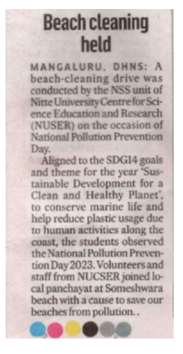
Lake Rejuvenation- A step towards protection of aquatic habitats:
As a part of the University's initiatives towards the sustainable development and protection of planet earth and its inhabitants, NUCSER adopted a public lake, the Someshwar Temple lake at Ullal, Mangaluru and organized an event called ?Lake Rejuvenation? on 16th December 2023. The faculty and research scholars of NUCSER actively participated in this event aimed at cleaning the lake and its surroundings including the removal of weed plants from the lake's surroundings, removal of plastic waste from the lake, and the collection of plastics and other debris from the lake's vicinity in an effort towards making the water bodies clean and safe. Additionally, the team displayed placards adorned with slogans promoting water body conservation and protection to raise awareness among the public. The initiative taken up by NUCSER proved fruitful as it made a significant impact on the cleanliness of the lake and its surroundings which would encourage people to keep aquatic bodies clean and protected.
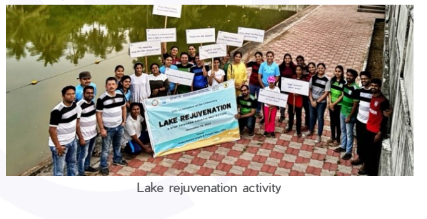
Lake Rejuvenation Activity Good Aquatic Stewa- rdship Award To Aquatic Biosystems:
As a part of sustainable development goals initiatives, Nitte DU conferred Aquatic Biosystems, located at Vamanjoor, Mangaluru, with ?Good Aquatic Stewardship Award? for practicing scientific and sustainable approaches in ornamental fish farming on 26th December 2023. On behalf of the University, Prof. Dr. Anirban Charkraborty, Director, NUCSER along with a team of faculty and research scholars from NUCSER felicitated the founding directors of Aquatic Biosystems, Dr.Ashwin Rai and Mr. Ronald D'Souza, with the award and a citation for their contributions to sustainable utilization of water resources.
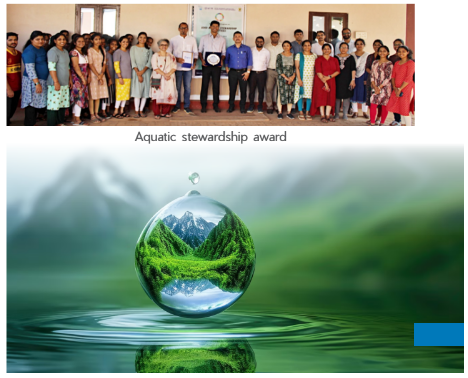
Monitoring The Health Of Aquatic Ecosystems :
Groundwater Analysis:
In India, ground water is highly polluted with chemicals that runoff from industrial and agricultural wastes, and microbial contamination arises due to sewage contamination. Routine monitoring of groundwater would provide for surveillance and prompt intervention to mitigate further damages. Increased anthropogenic activities have caused a drastic increase in both chemicals and microbial pollution in fresh waters. Groundwater samples from various locations in Mangalore were collected and tested for the presence of chemical parameters beyond permissible limits and microbiological quality.
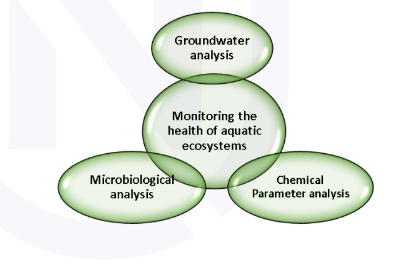
Analysis of Chemical Parameters:
Heavy metals interfere with the normal physiology of the human body. It binds to cellular components, leading to dysfunction of the metabolic processes in our body. This study was undertaken to study the geospatial distribution of selected heavy metals in open-well waters within Mangalore City Corporation limits. Water samples were collected from all 60 wards in the jurisdiction of Mangalore City Corporation. The fluoride concentration was estimated using the spectrophotometric method using the Sodium 2-(parasulfophenylazo)-1,8-dihydroxy3,6-naphthalene disulfonate (SPADNS) reagent. Similarly, iron was estimated using the phenanthroline reagent. The findings report that the pH of the samples was acidic in 20 wards. Panambur, Kunjathbail North, Mannagudda, Court, and Cantonment water was colored. Kunjathbail (North), Kunjathbail (South), Kambala, Kadri North, Bendoor, Bolar, Mannagudda, and Markada, showed high turbidity levels. The fluoride concentration in the samples collected from 60 wards of Mangalore city was less than 1.5ppm, which is the permissible limit by the World Health Organization. Iron is within the permissible limit except for the wards Court and Boloor, which showed an iron concentration of 0.4 ppm and 3.08 ppm, respectively. However, arsenic was not detected in any of the 180 samples collected from the 60 wards of Mangalore City Corporation.
Microbiological Analysis:
Water samples from various locations in Mangalore city were sampled and tested for potability, fecal coliforms, and total coliforms. In cases where the water was found to be contaminated, corrective measures were suggested. Follow-up analyses were also conducted to monitor the quality. The biodiversity of the water body in the upcoming Nitte campus was also studied.
Collaborate with the local community in efforts to support shared aquatic ecosystems:
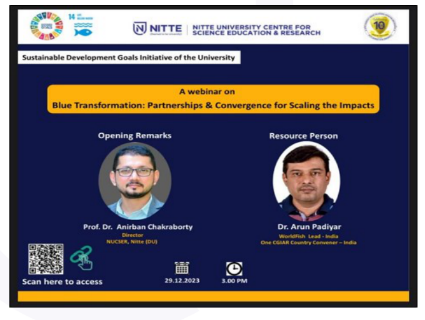
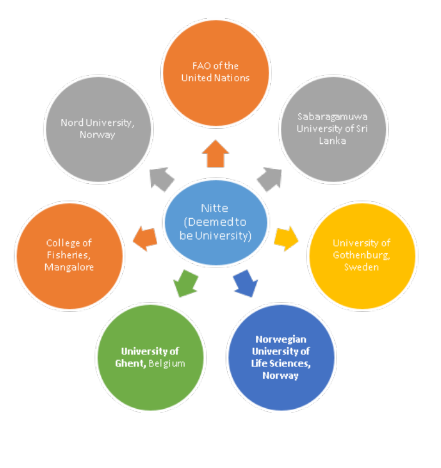
EDUCATIONAL PROGRAM ON WATER ECOSYSTEM
DBT sponsored postgraduate programme on Marine Biotechnology:
Nitte (Deemed to be University) run Department of Biotechnology, Government of India sponsored postgraduate programme on Marine Biotechnology at Nitte University Centre for Science Education & Research (NUCSER). The focus in Marine Biotechnology program is to provide appropriate theoretical knowledge and laboratory skills for the development of various biotechnological tools and technologies in marine sciences and to implement the needs of the economy through marine entrepreneurship, study of marine environmental systems and fisheries, development of marine biotechnological processes. The program provides training in basic and advanced skills meant to empower youth to develop the sustainable strategy of harnessing the marine environment for food, medicines, and other resources.

Field trip for M.Sc. Marine Biotechnology students:
The students of MSc Marine Biotechnology visited the College of Fisheries, Mangalore on 11th March 2023, as a part of the skill-based course. Prof. Dr. Shivakumar Magada, Dean of the College provided an overview on fisheries sciences and the importance of marine biotechnology for the development of the nation. Students visited different departments such as Fisheries resources management, Fisheries aquatic environment and Aquatic animal health management to gain knowledge on fish immunology, aquatic and benthic resources and biodiversity and conservation.
Visit of NUCSER students to KFDC AND CMFRI:
As part of curriculum involving bioprocess technology course, students from first year MSc Marine Biotechnology and 2nd MSc Marine biotechnology, Biotechnology and Food Safety and Biotechnology visited the Karnataka Fisheries Development Corporation Limited (KFDC Ltd.) and Central Marine Fisheries Research Institute (CMFRI) facility on 16th October 2023.
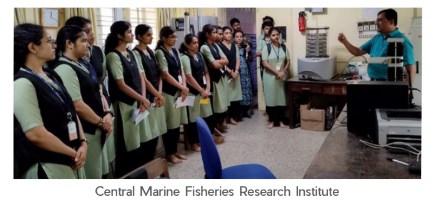
Visit of NUCSER students to the wastewater plant:
As a part of the academic curriculum the PG (M.Sc. Microbiology and M.Sc. Biotechnology) students of NUCSER, visited the wastewater plant located at Mullakad, Kavoor Rd, Gandhi Nagar, Kavoor, Mangalore on 21st Nov 2023.
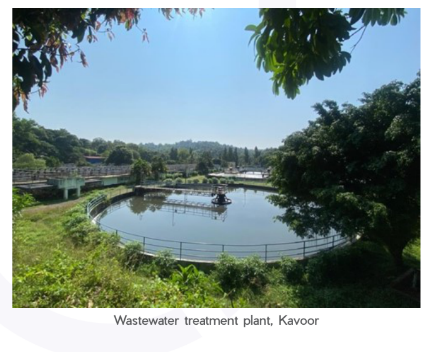
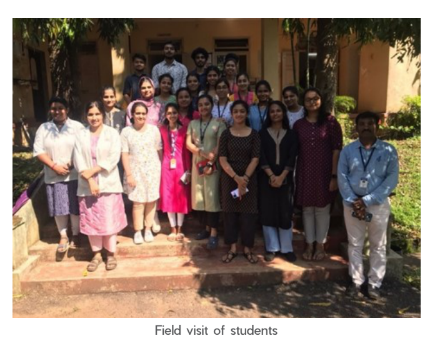
EDUCATIONAL PROJECT ON FRESH-WATER ECOSYSTEMS
Bacterial Remediation and Toxicity Analysis of Polystyrene Microplastics:
There has been worldwide awareness on microplastic occurrence, toxicity, and effects on ecosystems due to their detection in virtually every part of the universe. On microbial exposure, structural breakdown, and weight reduction of microplastics have been noted by many researchers, with few exploring polyaromatic hydrocarbon degrading strain due to structural similarities between PAH and benzene ring containing microplastics. Hence, in the present study, a PAH degrading Pseudomonas strain was utilized to degrade benzene ring containing polystyrene microplastics. The degradation of PS MPs by Pseudomonas strain was assessed for a period of 45 days along with analysis of biodegradation kinetics. Predominant Structural and compositional differences were assessed by FESEM and FT-IR studies. Comparative toxicity effects of pristine and degraded PS MPs were tested on freshwater snail Pomacea canaliculata and Danio rerio embryos. Substantial weight reduction was attained in 45 days with considerable differences in behavioral, oxidative stress and bioaccumulation patterns in both the living systems.
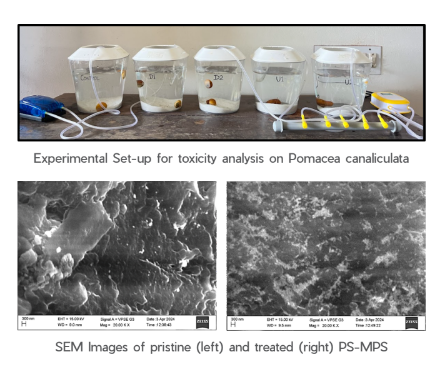
A novel fish classification system using deep learning algorithm Protecting and enhancing aquatic ecosystems:
With the increasing importance of fisheries management and biodiversity conservation, accurate and efficient fish classification system is required. Traditional methods often rely on manual identification which is time consuming and prone to errors. In the proposed work, the separation of fishes in coastal regions is automated. The automation is done using electromechanical systems. The electromechanical systems consist of a conveyor belt, camera, Machine Learning algorithm and separating mechanism for fish classification. Machine Learning algorithm MobileNetV2 is used to classify the fishes based on their species. The developed system is tested against different field conditions such as illumination effects, background effects and is found to be accurate. The developed system can classify five different species of fishes available in the Mangalore coast in real-time and address the labour issues faced in fish management.
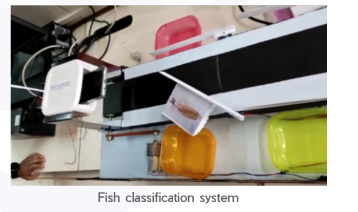
Fisherman safety alert system:
The fishing industry plays a vital role in the global economy, providing livelihoods for millions of people and supplying food to communities worldwide. However, challenges such as overfishing, environmental degradation, and inefficient resource management have put immense pressure on fisheries sustainability. In response to these challenges, there is a growing need for innovative technologies that can empower fishermen with real-time data and enhance their ability to make informed decisions. One such technology that holds great promise for revolutionizing the fishing industry is Long-Range (LoRa) communication. LoRa is a wireless communication technology known for its long-range capabilities, low power consumption, and suitability for Internet of Things (IoT) applications. By leveraging LoRa technology, fishermen can access a range of benefits that improve their operational efficiency, environmental sustainability, and overall profitability. The deployment of compact and durable LoRa-enabled devices, equipped with GPS functionality and a distress button, ensures that fishermen can swiftly transmit distress signals in emergencies, thereby significantly improving their chances of receiving prompt assistance.
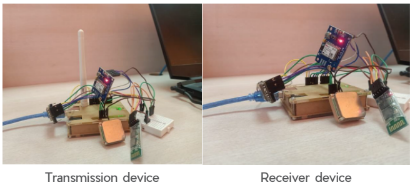
Underwater v2v communication system:
The evolution of underwater communication represents a pivotal advancement catering to the intricate demands of submerged environments. Underwater communication systems facilitate the seamless exchange of information, enhancing our ability to monitor and manage marine ecosystems effectively. This technology empowers researchers to gather data remotely, reducing the need for physical interventions that might disturb delicate underwater habitats. Additionally, it contributes to a comprehensive understanding of underwater ecosystems by providing insights into biodiversity, habitat health, and ecosystem dynamics. The development of underwater communication serves as a cornerstone for sustainable marine management and the conservation of our planet's precious aquatic resources.
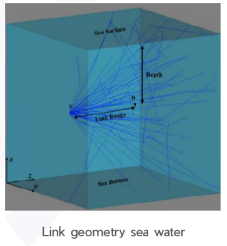
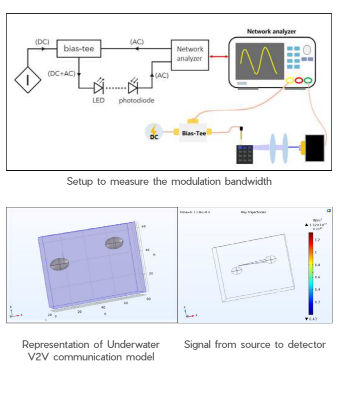
PROJECT ON REDUCING PLASTIC WASTE ON CAMPUS
Manufacturing of bricks using waste plastics:
In present time due to urbanization the plastic utilization in our daily life has been increased significantly as it being very useful and popular material. The only disadvantage is non- biodegradability. This study summarizes the work done to use plastic as construction material in bricks. The recyclable properties of plastic waste can be utilized to recycle this waste and produce a new product having lesser negative impact on the environment. One of the options to recycle plastic waste is to form bricks of plastics by mixing plastics with sand which can be used to replace traditional bricks. Various comparative study with brick made up of other materials by using various testing method such as fire- resistant test, water absorption, apparent porosity test, soundness test, efflorescence test and analysed that the further research on this field can enrich the strength, quality, and durability of these bricks. These bricks absorb very less water as compared to conventional bricks that is also significant with the view of environmental sustainability.

Key observations:
- Plastic bricks are superior in comparison with local sand bricks as they as
more economical, high compressive strength, low water absorption and light weighted.
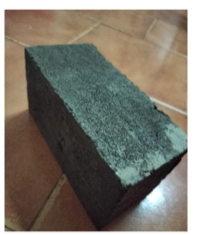


.png)
